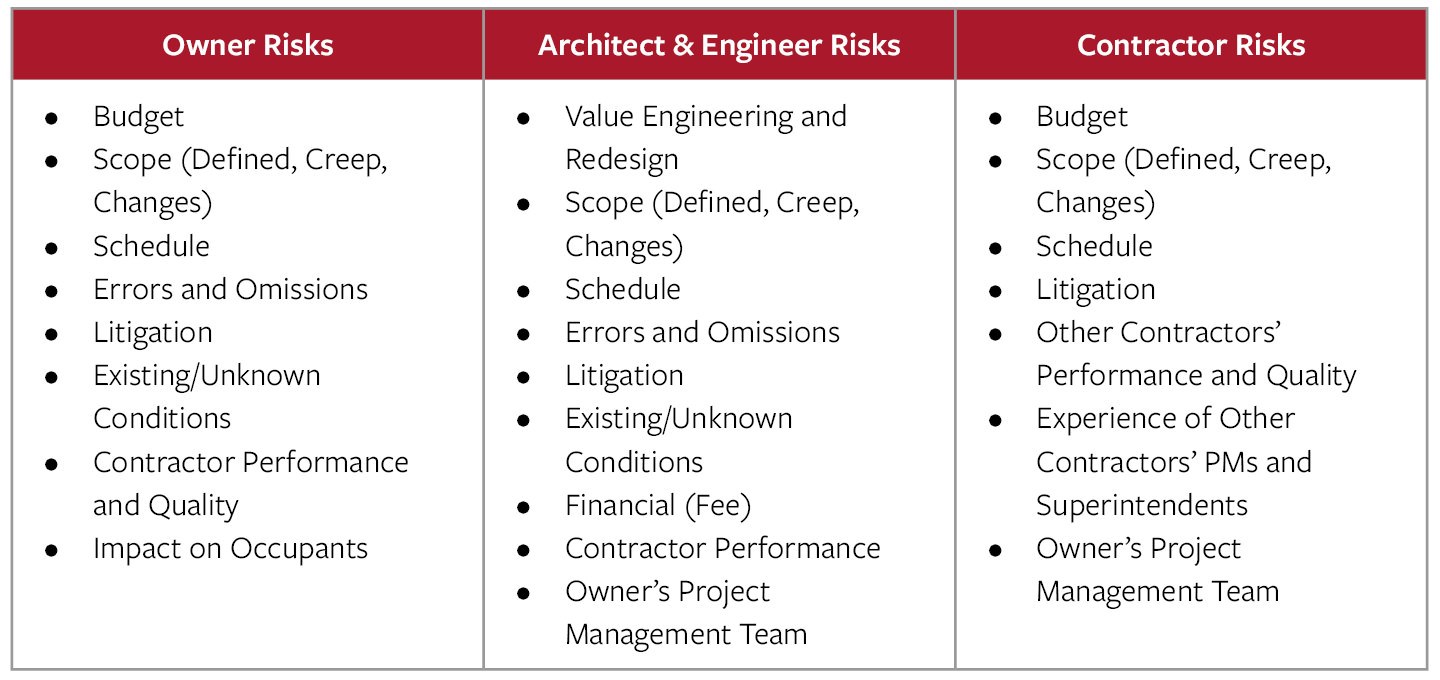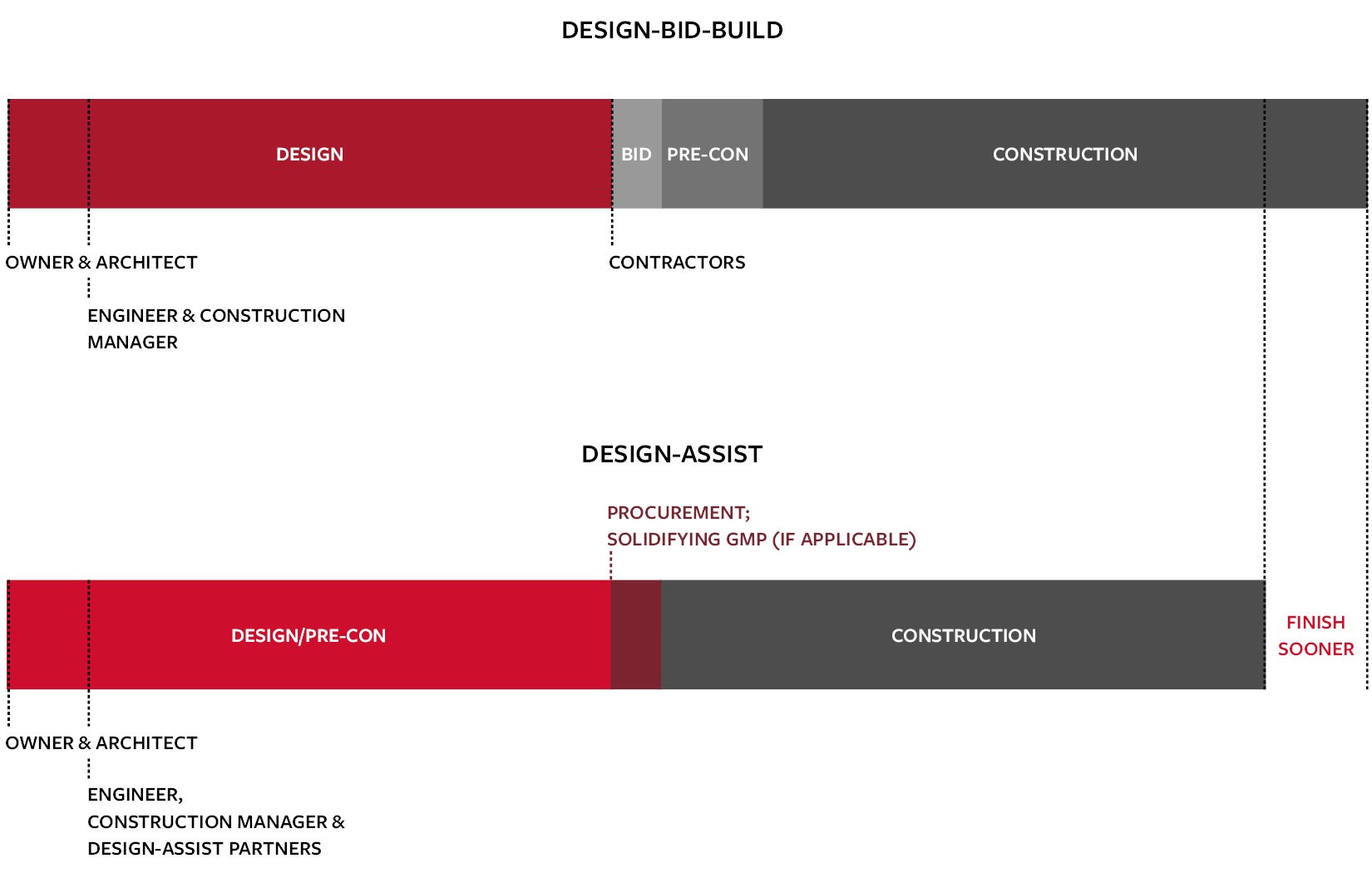How Design-Assist Reduces 6 Common Risks on Projects
By James T. Cicero | Feb 22, 2018

On construction projects, every team member takes on a certain amount of risk. Then, during the project, they each work to limit their share of the risk. The results can be combative and detrimental to the project.
As I’ve worked with the design-assist delivery model, I’ve witnessed far less risk and better outcomes for everyone. As a business owner, those results are incredibly attractive.
What are the risks, and how can design-assist help?
Here, we’ll look at six common risks on projects: budget and scope, schedule, existing conditions, errors and omissions, a combative environment, and profitability. Then, we’ll look at how design-assist’s collaborative approach helps teams limit risk and deliver more value.
Whose risk is it?
I’m a founding partner of the Cogence Alliance, an organization dedicated to improving project outcomes through team-based delivery methods. Cogence is made up of owners, architects, engineers, construction manages, trade partners, and other industry affiliates.
In some of our roundtable discussions, we’ve spent time identifying the risks on construction project, as well as who owns the risk. Here are just a handful:

As the table illustrates, many of the risks are shared among the owner, architect/engineer, and contractors. At the same time, those risks tend to flow upstream to the owner, who is the ultimate risk-holder. By investing in pre-construction design-assist contractor services, though, owners can manage many of these risks and control costs.
1. Budget & Scope
Budget and scope are top concerns on a project.
One of the challenges that owners consistently face is formulating an accurate budget and scope. They have to start somewhere if they’re going to get funding approval or begin planning.
Unfortunately, they generally don’t have much to go on. They’re often working with very little real information. I’ve seen square foot estimates, napkin estimates, and “We had a favor coming from the contractor, so he estimated it” estimates. They’re also estimating a number before the project team is together.
Once a project is underway, the original budget estimate may go unchecked until a good portion of the design is complete. Then, they discover the real budget for the desired scope, and the value engineering and redesign process begins.
With design-assist, accurate cost information facilitates decision-making during design.
Members of the construction team, who join the project during design, provide real-time cost estimating. The owner can make decisions about budget and scope throughout design, rather than as part of value engineering exercises. The team can adjust the design based on real-time budget feedback. Further, the construction team has been part of the design, so they have a deep understanding of design intent and constructability. As a result, owners will see fewer changes or additions during construction.
Fast, high-level estimating takes an experienced contractor. These contractors have the ability to fill in the scope gaps with reasonable assumptions.
See 4 Key Components of Design-Assist for more information on design-assist and real-time cost estimating.
2. Schedule
Schedule is another high-risk item, as schedule delays can have both financial and operational consequences for owners.
With traditional delivery methods, the construction team has little input on the construction schedule. They receive a deadline and have to get moving. They don’t get time to plan in efficiencies.
With design-assist, the construction team gains opportunities for schedule efficiencies:
- They are able to offer input into constructability, phasing, and long-lead materials.
- They have the time to sink their teeth into the design and create more effective construction plans.
- They can roll straight from design into construction, avoiding the bidding and contract negotiation phase.
- They can saves weeks of coordination time compared with design-bid-build, because with a successful design-assist approach, construction BIM models are typically close to completion at the end of the design phase.
- They can work more efficiently during construction, because they have a better understanding of design intent and a better plan for construction.
Here’s an illustration of how using design-assist can translate into schedule efficiencies:

Here’s a real example: We completed an emergency department renovation using design-assist. The team was working out a multi-phase approach, and they ran into a roadblock: The optimal MEPT phasing was exactly the reverse of the optimal occupied ED phasing.
The electrical designer proposed a Phase 0, where they would build the new electrical room in advance so that the remaining phases could progress more quickly. The electrical contractor, who was in the room, affirmed not only that a Phase 0 would work, but that it could save the owner time and money. The team adopted their suggestion. The construction schedule decreased significantly, without impacting the occupied portions. (With all our design-assist efficiencies, we completed the project two months early.)
If the electrical contractor hadn’t been in the room and empowered to provide input, the whole team, especially the owner, would have lost out.
3. Errors & Omissions
Errors and omissions (E&Os) are a financial risk, especially for the owner. Generally speaking, when a design error or omission falls within the standard of care, the owner ends up paying for the subsequent change order.
As an engineer, though, I don’t want to cost the owner extra money during construction. I want to make sure my design works. I also want to protect myself and my company from loss or litigation.
As a result, within a traditional delivery method, I might create more conservative system designs (“belt and suspenders”). If there’s a question in my mind about constructability, for example, I’m going to be more conservative with my design. While a more conservative design is likely to be more expensive, we’ve also found that owners would rather account for all expenses up front (and have the contractor find a way to save money during construction) than have unexpected costs later. It makes sense.
With design-assist, the construction team’s input can reduce errors and omissions. They’re the experts on construction, and they help the team develop more construction-friendly designs. Their input on constructability can reduce uncertainty, which allows us to be less conservative with our designs.
Here’s a practical example: Let’s say I’m working on a renovation, and I need to run a new 4-inch electrical conduit. In a traditional delivery method, I’ll make a site visit on my own. If I see that I have a few feet of space above the ceiling, I know that I can run the conduit straight through. If I only have one foot above the ceiling, I’m not going to be nearly as confident.
As a result, I’m going to pick a different route, one I’m confident will not be obstructed. It might be a longer route, but it’s preferable to a costly change order. On the other hand, if I’d had a design-assist contractor next to me during the site visit, he could have told me whether he could run my 4-inch conduit through a one-foot space. If he said he could, then I’d be able to take that route with confidence and save the owner money.
4. Existing Conditions
As with errors and omissions, existing conditions are a financial risk, especially for the owner.
The design-assist process reduces the owner’s exposure to existing conditions. By having the contractors on board early, they can participate in field investigations. As the engineer is describing equipment and system tie-in locations, the contractor can verify space availability, system capacities, and existing equipment operations. This process helps eliminate the existing conditions change orders that an owner typically sees on a project.
(We’ll be talking about existing conditions at greater length in the near future.)
5. Combative Environment
Traditional delivery methods tend to foster a combative environment, where each firm is concerned about its own risk and profitability. When something goes wrong, blame and finger-pointing result.
Here are a couple examples:
- The plumbing engineer needs to route a waterline into a building, but there are a lot of structural elements in the way. The structural engineer tells the plumbing engineer that it’s their responsibility to get around the structure, because the structural engineer is already done with design. (I’m not picking on structural engineers. This is a typical response across disciplines.) When one team has already completed their design, having to go back and redo it is only going to cost them money and eat their profit.
- During construction, the first contractor to arrive gets the space for their systems. Then, all the other contractors have to work around the first systems installed. This method can result in redoing work and change orders.
Design-assist instead creates a team environment. The designers and contractors collaborate from the beginning. They build relationships, and they gain empathy for one another. As I’ve worked on design-assist projects, I’ve developed an understanding of the risks my teammates face, and how I can help mitigate those risks.
With the examples above, here’s how design-assist helps:
- The plumbing and structural teams, with the help of the design-assist partner, would evaluate the cost to reroute the waterline versus the cost to modify the structure. They would work together to develop a solution.
- The different trades would have talked through system installation and make a plan prior to construction.
In my experience, risk mitigation leads to less litigation among team members. The reduction in litigation allows all parties, especially the owner, to devote their resources to the project rather than a litigation effort.
Plus, design-assist projects are fun to work on. I’ve developed quality relationships with people I would have never even talked to on a typical job. Electrical engineers befriending mechanical contractors, mechanical engineers learning about drywall (e.g. king studs), architects learning about flex duct…I’ve seen all these kinds of things thanks to design-assist, and I’ve had fun doing it.
6. Profitability
With traditional delivery methods, both designers and contractors have projects that are big winners and projects that are big losers. It’s not the most predictable business model.
With design-assist, the project is structured to reduce risk for everyone.
- Designers and contractors know they will receive a reasonable profit that’s somewhere between their big losers and their big winners.
- The owner understands that they are paying a fee that gives the design and construction teams their average profit. In return, the owner is gets a strong and cooperative team. They’re not going to get hit with extras along the way.
For me as an engineer and business owner, it’s a no-brainer.
What I’ve witnessed is that when you take the risk off the table, everyone can focus their energy on the project. They aren’t focused on their profitability or risk. They’re focused on making the project better – which is a big win for owners.